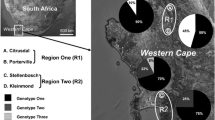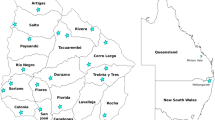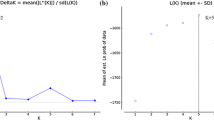Abstract
Holocryphia eucalypti is a fungal pathogen that causes stem cankers on Eucalyptus species in South Africa and Australia. In South Africa it is considered opportunistic but in Australia it has been associated with occasional but serious disease problems. The aim of this study was to determine the genetic structure of a South African population of H. eucalypti and compare it with three Australian populations of the fungus. Seventy-two isolates from Eucalyptus spp. and clones in South Africa were compared with 30 isolates from E. globulus and 24 isolates from Corymbia calophylla in the south of Western Australia and 23 isolates from E. dunnii in eastern Australia.DNA of these isolates was amplified using eight pairs of microsatellite markers previously developed for H. eucalypti. Nei’s gene diversity (H) showed that the eastern Australian population is the most genetically diverse and the Western Australian populations from Corymbia and Eucalyptus are somewhat less diverse. The South African population displayed the lowest genetic diversity. The high genetic diversity in the Australian populations supports the view that H. eucalypti is native to that region and was introduced into South Africa.
Similar content being viewed by others
References
Agapow P-M, Burt A (2001) Multilocus 1.2. Available at http://www.bio.ic.ac.uk/evolve/software/multilocus [Verified 18 January 2008]
Anon. (2006) Forestry South Africa. Forestry 8FP Industry Facts 2005. Available at http://www.forestry.co.za [Verified 18 January 2008]
Barnes I, Nakabonge G, Roux J, Wingfield BD, Wingfield MJ (2005) Comparison of populations of the wilt pathogen Ceratocystis albifundus in South Africa and Uganda. Plant Pathology 54, 189–195. doi: 10.1111/j.1365-3059.2005.01144.x
Barton NH, Charlesworth B (1984) Genetic revolutions, founder effects, and speciation. Annual Review of Ecology and Systematics 15, 133–164. doi: 10.1146/annurev.es.15.110184.001025
Beadle NCW (1981) ‘The vegetation of Australia.’ (Cambridge University Press: Cambridge)
Boland DJ, Brooker MIH, Chippendale GM, Hall N, Hyland BPM, Johnston RD, Kleinig DA, Turner JD (1984) ‘Forest trees of Australia.’ (CSIRO Publishing: Melbourne)
Burgess T, Gordon TR, Wingfield MJ, Wingfield BD (2004a) Geographic isolation of Diplodia scrobiculata and its association with native Pinus radiata. Mycological Research 108, 1399–1406. doi: 10.1017/S0953756204001443
Burgess T, Wingfield MJ, Wingfield BD (2004b) Global distribution of Diplodia pinea genotypes as revealed using SSR markers. Australasian Plant Pathology 33, 513–519. doi: 10.1071/AP04067
Carnegie AJ (2007) Forest health condition in New South Wales, Australia, 1996–2005. II. Fungal damage recorded in eucalypt plantations during forest health surveys and their management. Australasian Plant Pathology 36, 225–239. doi: 10.1071/AP07021
Cockerham CC, Weir BS (1993) Estimation of gene flow from F-statistics. Evolution 47, 855–863. doi: 10.2307/2410189
Davison EM, Coates DJ (1991) Identification of Cryphonectria cubensis and Endothia gyrosa from eucalypts in Western Australia using isozyme analysis. Australasian Plant Pathology 20, 157–160. doi: 10.1071/APP9910157
Denison NP, Kietzka JE (1993) The use and importance of hybrid intensive forestry in South Africa. South African Forestry Journal 165, 55–60.
Gryzenhout M, Eisenberg BE, Coutinho TA, Wingfield BD, Wingfield MJ (2003) Pathogenicity of Cryphonectria eucalypti to Eucalyptus clones in South Africa. Forest Ecology and Management 176, 427–437. doi: 10.1016/S0378-1127(02)00309-2
Gryzenhout M, Myburg H, Hodges CS, Wingfield BD, Wingfield MJ (2006) Microthia and Holocryphia, two new genera of fungi from Eucalyptus representing the species previously known as Cryphonectria havanensis and Cryphonectria eucalypti. Studies in Mycology 55, 35–52.
Jackson T (2004) Environmental factors and host characteristics influencing the susceptibility of Eucalyptus globulus to Endothiella eucalypti in southwestern Australia. PhD Thesis, Murdoch University, Perth.
Kumar S, Tamura K, Jakobsen IB, Nei M (2001) ‘MEGA2: molecular evolutionary genetics analysis software.’ (Arizona State University: Tempe, AZ)
McDonald BA (1997) The population genetics of fungi. Tools and techniques. Phytopathology 87, 448–453. doi: 10.1094/PHYTO.1997.87.4.448
McDonald BA, Linde C (2002) The population genetics of plant pathogens and breeding strategies for durable resistance. Euphytica 124, 163–180. doi: 10.1023/A:1015678432355
McDonald BA, McDermott JM (1993) Population genetics of plant pathogenic fungi. Bioscience 43, 311–319. doi: 10.2307/1312063
McDonald BA, Miles J, Nelson LR, Pettway RE (1994) Genetic variability in nuclear DNA in field populations of Stagonospora nodorum. Phytopathology 84, 250–255. doi: 10.1094/Phyto-84-250
Milgroom MG, Fry WE (1997) Contributions of population genetics to plant disease epidemiology and management. Advances in Botanical Research 24, 1–30.
Milgroom MG, Lipari SE, Ennos RA, Liu Y-C (1993) Estimation of the outcrossing rate in the chestnut blight fungus, Cryphonectria parasitica. Heredity 70, 385–392.
Nakabonge G, Cortinas MN, Roux J, Gryzenhout M, Wingfield BD, Wingfield MJ (2005) Development of polymorphic microsatellite markers for the fungal tree pathogen Cryphonectria eucalypti. Molecular Ecology Notes 5, 558–561. doi: 10.1111/j.1471-8286.2005. 00990.x
National Forest Inventory (2007) ‘Australia’s plantations 2007 — inventory update.’ (Bureau of Rural Sciences: Canberra)
Nei M (1972) Genetic distance between populations. American Naturalist 106, 283–292. doi: 10.1086/282771
Nei M (1973) Analysis of gene diversity in subdivided populations. Proceedings of the National Academy of Sciences of the United States of America 70, 3321–3323. doi: 10.1073/pnas.70.12.3321
Old KM, Murray DIL, Kile GA, Simpson J, Malafant KWJ (1986) The pathology of fungi isolated from eucalypt cankers in south-eastern Australia. Australian Forest Research 16, 21–36.
Stoddart JA, Taylor JF (1988) Genotypic diversity: estimation and prediction in samples. Genetics 118, 705–711.
Taylor JW, Jacobson DJ, Fisher MC (1999) The evolution of asexual fungi: reproduction, speciation and classification. Annual Review of Phytopathology 37, 197–246. doi: 10.1146/annurev.phyto.37.1.197
Van der Westhuizen IP, Wingfield MJ, Kemp GHJ, Swart WJ (1993) First report of the canker pathogen Endothia gyrosa on Eucalyptus in South Africa. Plant Pathology 42, 661–663. doi: 10.1111/j.1365-3059.1993. tb01548.x
Venter M, Myburg H, Wingfield BD, Coutinho TA, Wingfield MJ (2002) A new species of Cryphonectria from South Africa and Australia, pathogenic to Eucalyptus. Sydowia 54, 98–117.
Walker J, Old KM, Murray DIL (1985) Endothia gyrosa on Eucalyptus in Australia with notes on some other species of Endothia and Cryphonectria. Mycotaxon 23, 353–370.
Wardlaw TJ (1999) Endothia gyrosa associated with severe stem cankers on plantation grown Eucalyptus nitens in Tasmania. European Journal of Forest Pathology 29, 199–208. doi: 10.1046/j.1439-0329.1999.00143.x
Weir BS (1996) Intraspecific differentiation. In ‘Molecular systematics’. 2nd edn. (Eds DM Hillis, C Moritz, B Mable) pp. 385–405. (Sinauer: Sunderland, MA)
Wingfield MJ (2003) Daniel McAlpine Memorial Lecture. Increasing threat of diseases to exotic plantation forests in the Southern Hemisphere: lessons from Cryphonectria canker. Australasian Plant Pathology 32, 133–139. doi: 10.1071/AP03024
Wingfield MJ, Roux J (2000) Plantation diseases of South African forest plantations. In ‘South African forestry handbook. 1’. (Ed. DL Owen) pp. 241–252. (The South African Forestry Institute: Menlo Park, Republic of South Africa)
Wingfield MJ, Roux J, Coutinho T, Govender P, Wingfield BD (2001) Plantation disease and pest management in the next century. Southern African Forestry Journal 190, 67–72.
Workman PL, Niswander JD (1970) Population studies on south western Indian tribes. II. Local genetic differentiation in the Papago. American Journal of Human Genetics 22, 24–49.
Yeh FC, Yang R-C, Boyle T (1999) ‘POPGENE. Release 1.31. Microsoft windows-based freeware for population genetic analysis.’ (University of Alberta: Edmonton)
Yuan ZQ, Mohammed CL (1997) Investigation of fungi associated with stem cankers of eucalypts in Tasmania, Australia. Australasian Plant Pathology 26, 78–84. doi: 10.1071/AP97013
Author information
Authors and Affiliations
Corresponding author
Rights and permissions
About this article
Cite this article
Nakabonge, G., Burgess, T., Gryzenhout, M. et al. Population structure of the fungal pathogen Holocryphia eucalypti in Australia and South Africa. Australasian Plant Pathology 37, 154–161 (2008). https://doi.org/10.1071/AP08004
Received:
Accepted:
Issue Date:
DOI: https://doi.org/10.1071/AP08004




